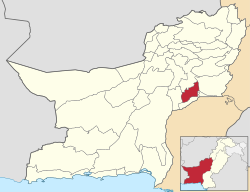User:Muhammad Noman Abbasi/sandbox
| This is not a Wikipedia article: It is an individual user's work-in-progress page, and may be incomplete and/or unreliable. For guidance on developing this draft, see Wikipedia:So you made a userspace draft. Find sources: Google (books · news · scholar · free images · WP refs) · FENS · JSTOR · TWL |
Naseerabad District
ضلع نصیر آباد | |
|---|---|
District in Balochistan, Pakistan | |
 Map of Balochistan with Nasirabad District highlighted | |
| Country | |
| Province | |
| Division | Nasirabad |
| Headquarters | Dera Murad Jamali |
| Government | |
| • Type | District Administration |
| • Deputy Commissioner | Muhammad Qasim |
| • District Police Officer | N/A |
| • District Health Officer | N/A |
| Area | |
• Total | 3,387 km2 (1,308 sq mi) |
| Population (2017)[1] | |
• Total | 487,847 |
| • Density | 140/km2 (370/sq mi) |
| Time zone | UTC+5 (PST) |
Naseerabad District (ضلع نصیر آباد) is a district located in the central-western region of Balochistan, Pakistan. The district's administrative center is in Dera Murad Jamali.
The district was originally named Temple Dera, after Captain H. M. Temple, a British civil servant who served as the Political Agent for Sibi from 1891 to 1892. Among the local population, it is still referred to as 'Tipul,' which is a local variation of the word 'temple.'
Previously a part of Kalat District, Naseerabad gained the status of a separate district in 1974. In 1987, a new district, Jaffarabad, was carved out of Naseerabad. From July 1987 to December 1990, it was known as Tahseel Tamboo, named after a small village, Tamboo, located 40 km west of Dera Murad Jamali.
Administrative divisions
[edit]Tehsils: - Dera Murad Jamali (district headquarters) - Chhatter - Baba Kot - Tamboo
Union councils
[edit]The district is divided into 31 union councils and one municipal committee across its various tehsils.
EGDI Status of Naseerabad District
[edit]Naseerabad District is a district in the Balochistan province of Pakistan. It was formerly part of Kalat District, but became a separate district in 1974³. According to the UN E-Government Survey 2022¹, Pakistan ranked **152nd** out of 193 countries in the overall E-Government Development Index (EGDI), which is a measure of how countries use information and communication technologies to deliver public services. The EGDI is composed of three sub-indices: online service index (OSI), telecommunication infrastructure index (TII), and human capital index (HCI). Pakistan scored **0.362** in OSI, **0.137** in TII, and **0.499** in HCI, with an overall EGDI score of **0.333**².
The UN E-Government Survey 2022 also included a study of local e-government development based on the United Nations Local Online Service Index (LOSI), which assessed the online presence of 40 cities per country. However, Naseerabad District was not one of the cities selected for Pakistan, so there is no specific data on its LOSI score or online service delivery. The national average LOSI score for Pakistan was **0.183**, which is below the global average of **0.346**². This means that Pakistan has a low level of online service delivery and digital inclusion at the local level.
To improve its e-government development, Naseerabad District can learn from the best practices of other districts and cities in Pakistan and abroad that have achieved high scores in the EGDI and LOSI. For example, Islamabad, Karachi, and Lahore are some of the cities in Pakistan that have higher LOSI scores than the national average². They have implemented various initiatives to enhance their online service provision, such as e-filing systems, e-procurement platforms, e-health services, and e-learning portals¹. Similarly, Seoul, Singapore, Helsinki, London, and New York are among the top five cities in the LOSI ranking globally, with scores above **0.8**². They have leveraged their local resources and capacities to provide innovative and inclusive online services to their citizens and businesses¹.
Source: Conversation with Bing, 10/29/2023 (1) Nasirabad District - Wikipedia. https://en.wikipedia.org/wiki/Nasirabad_District. (2) UN E-Government Survey 2022 - United Nations. https://publicadministration.un.org/egovkb/en-us/Reports/UN-E-Government-Survey-2022. (3) Overview > E-Government Development Index - United Nations. https://publicadministration.un.org/egovkb/en-us/About/Overview/-E-Government-Development-Index.
Demographics
[edit]According to the 2017 census, Naseerabad District had 64,302 households and a population of 487,847. The district had a sex ratio of 939 females per 1000 males and a literacy rate of 23.30%, with 33.22% for males and 12.97% for females. Approximately 19.74% of the population lived in urban areas, and 39.40% were under 10 years of age.
Religions in Nasirabad district (2017): - Islam: 99.26% - Hinduism: 0.66% - Other or not stated: 0.08%
Languages in Nasirabad district (2017): - Balochi: 39.05% - Brahui: 22.89% - Sindhi: 21.22% - Saraiki: 15.21% - Others: 1.63%
References
[edit]Catagories
[edit]- Nasirabad District - Districts of Pakistan - Districts of Balochistan, Pakistan

